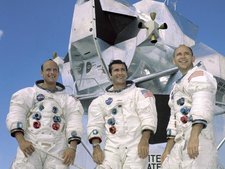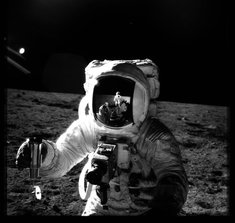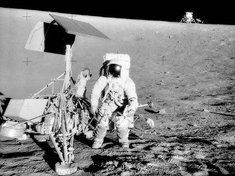Apollo 12
|
|
| Mission Insignia | |
|---|---|

| |
| Mission Statistics | |
| Mission Name: | Apollo 12 |
| Call Sign: | Command module: Yankee Clipper Lunar module: Intrepid |
| Number of Crew: | 3 |
| Launch: | November 14, 1969 16:22:00 UTC Kennedy Space Center LC 39A |
| Lunar Landing: | November 18, 1969 06:54:35 UTC 3° 0' 44.60" S - 23° 25' 17.65" W Oceanus Procellarum (Ocean of Storms) |
| Lunar EVA length: | 1st: 3 h 56 min 03 s 2nd: 3 h 49 min 15 s Total: 7 h 45 min 18 s |
| Lunar Surface Time: | 31 h 31 min 11.6 s |
| Lunar Sample Mass: | 34.35 kg |
| Splashdown: | November 24, 1969 20:58:24 UTC 15° 47' S - 165° 9' W |
| Duration: | 10 d 4 h 36 min 24 s |
| Number of Lunar Orbits: | 45 |
| Time in Lunar Orbit: | 88 h 58 min 11.52 s |
| Mass: | CSM 28,838 kg; LM 15,235 kg |
| Crew Picture | |
| Apollo 12 Crew | |
Apollo 12 was the sixth manned mission in the Apollo program and the second to land on the Moon.
| Contents |
Crew
- Pete Conrad (flew on Gemini 5, Gemini 11, Apollo 12, & Skylab 2), commander
- Richard Gordon (flew on Gemini 9 & Apollo 12), command module pilot
- Alan Bean (flew on Apollo 12, Skylab 3), lunar module pilot
Backup Crew
- David Scott, commander
- Alfred Worden, command module pilot
- James Irwin, lunar module pilot
Support Crew
Mission Parameters
- Mass: CSM 28,838; LM 15,235 kg
- Perigee: 185 km
- Apogee: 189.8 km
- Inclination: 32.54°
- Period: 88.16 min
- Perilune: 115.9 km
- Apolune: 257.1 km
- Inclination: °
- Period: 120 min
- Landing Site: 3.01239 S - 23.42157 W (http://nssdc.gsfc.nasa.gov/planetary/lunar/lunar_sites.html) or
3° 0' 44.60" S - 23° 25' 17.65" W
LM - CSM Docking
- Undocked: November 19, 1969 - 04:16:02 UTC
- Redocked: November 20, 1969 - 17:58:20 UTC
EVAs
EVA 1 Start: November 19, 1969, 11:32:35 UTC
- Conrad - EVA 1
- Stepped onto Moon: 11:44:22 UTC
- LM ingress: 15:27:17 UTC
- Bean - EVA 1
- Stepped onto Moon: 12:13:50 UTC
- LM ingress: 15:14:18 UTC
EVA 1 End: November 19, 15:28:38 UTC
- Duration: 3 hours, 56 minutes, 03 seconds
EVA 2 Start: November 20, 1969, 03:54:45 UTC
- Conrad - EVA 2
- Stepped onto Moon: 03:59:00 UTC
- LM ingress: 07:42:00 UTC
- Bean - EVA 2
- Stepped onto Moon: 04:06:00 UTC
- LM ingress: 07:30:00 UTC
EVA 2 End: November 20, 07:44:00 UTC
- Duration: 3 hours, 49 minutes, 15 seconds
See also
Quote
Whoopie! Man, that may have been a small one for Neil, but that's a long one for me. —Pete Conrad
Mission Highlights
Missing image Apollo_12_Bean.jpg Alan Bean descends from the LM. (NASA) |
Missing image Surveyor_3_Conrad.jpeg Conrad jiggles the Surveyor III craft. (NASA) |
Shortly after liftoff from Cape Canaveral, the Saturn V rocket body was hit by a bolt of upper-atmosphere lightning. The CM's instruments went off-line for a few seconds, but power was quickly restored.
The S-IVB third stage was originally intended to be put into a solar orbit by venting the remaining propellant. However an extra long burn of the ullage motors meant that venting the remaining propellant in the tank of the S-IVB did not give the rocket stage enough energy to escape the Earth-Moon system and instead the stage ended up in a semi-stable orbit around the Earth after passing by the Moon in November 18, 1969. It finally entered into solar orbit 1971, but returned to Earth orbit (briefly) 31 years later. It was discovered by amateur astronomer Bill Yeung and he gave it the temporary designation J002E3 before it was determined to be an artificial, not natural, object.
The second lunar landing was an exercise in precision targeting. The descent was automatic, with only a few manual corrections by Conrad. The landing, in the Ocean of Storms, brought the lunar module "Intrepid" within walking distance — 155 meters — of a robot spacecraft that had touched down there two-and-a-half years earlier. Conrad and Bean brought pieces of the Surveyor 3 back to Earth for analysis, and took two Moon-walks lasting just under four hours each. They collected rocks and set up experiments that measured the Moon's seismicity, solar wind flux and magnetic field. Meanwhile Gordon, on board the Yankee Clipper in lunar orbit, took multispectral photographs of the surface. The crew stayed an extra day in lunar orbit taking photographs. When Intrepid's ascent stage was dropped onto the Moon after Conrad and Bean rejoined Gordon in orbit, the seismometers the astronauts had left on the lunar surface registered the vibrations for more than an hour.
Although Apollo 11 had made an almost embarrassingly imprecise landing well outside the designated target area, Apollo 12 succeeded, on November 19, in making a pin-point landing in the Ocean of Storms, within walking distance of the Surveyor 3 probe, which had landed there in April 1967. The astronauts remained on the Moon for thirty-one and a half hours, collecting samples and retrieving parts of the unmanned probe for study.
To improve the quality of television pictures from the Moon, a color camera was carried on Apollo 12 (unlike the monochrome camera that was used on Apollo 11). Unfortunately, when Bean carried the camera to the place near the lunar module where it was to be set up, he inadvertently pointed it directly into the Sun, destroying the vidicon tube. Television coverage of this mission was thus terminated almost immediately. By accident Bean left several rolls of exposed film on the lunar surface.
The Apollo 12 mission had landed on an area of the Ocean of Storms that had been visited earier by several unmanned missions (Luna 5, Surveyor 3, Ranger 7). The International Astronomical Union, recognizing this, christened this region Mare Cognitium (Known Sea). The landing site would thereafter be listed as Statio Cognitium on lunar maps (Conrad and Bean did not name their landing site, interestingly enough).
The command module and its crew were flawlessly recovered by the aircraft carrier USS Hornet. The ship is now open to the public as a museum in Alameda, CA.
The command module is displayed at the Virginia Air and Space Center, Hampton, Virginia and the lunar module impacted the Moon on 20 November, 1969 at 3.94 S, 21.20 W.
Statistics
- Launched: November 14, 1969 from Pad 39A
- Returned: November 24, 1969
- Crew members: Pete Conrad, commander; Dick Gordon, command module pilot; Alan Bean, lunar module pilot
- Command module: Yankee Clipper
- Lunar module: Intrepid
- Landed: November 19, 1969
- Lunar landing site: 3.2 S, 23.4 W -- Oceanus Procellarum (Ocean of Storms)
- On surface: 1 day 7.5 hours
- Lunar EVA: 7.7 hours (3.9 + 3.8)
- Samples: 34.4 kg
Reference
- Apollo 12 Characteristics - SP-4012 NASA HISTORICAL DATA BOOK (http://history.nasa.gov/SP-4012/vol3/table2.40.htm)
- Analysis of Surveyor 3 material and photographs returned by Apollo 12 (PDF) 1972 (http://ntrs.nasa.gov/archive/nasa/casi.ntrs.nasa.gov/19720019081_1972019081.pdf)
- Examination of Surveyor 3 surface sampler scoop returned by Apollo 12 mission (PDF) 1971 (http://ntrs.nasa.gov/archive/nasa/casi.ntrs.nasa.gov/19730064630_1973064630.pdf)
- Apollo 12 Mission Report (PDF) March 1970 (http://ntrs.nasa.gov/archive/nasa/casi.ntrs.nasa.gov/19760072997_1976072997.pdf)
- Analysis of Apollo 12 Lightning Incident, (PDF) February 1970 (http://ntrs.nasa.gov/archive/nasa/casi.ntrs.nasa.gov/19720066106_1972066106.pdf)
External links
- Image of mission patch (http://science.ksc.nasa.gov/history/apollo/apollo-12/apollo-12-patch.jpg)
- Map of surface activities for Apollo 12 (http://astrogeology.usgs.gov/Projects/LunarAtlas/maps/images/AP12Trav.jpg)
- Apollo 12 entry in Encyclopedia Astronautica (http://www.astronautix.com/flights/apollo12.htm)
- NASA NSSDC Master Catalog (http://nssdc.gsfc.nasa.gov/nmc/sc-query.html)
- APOLLO BY THE NUMBERS: A Statistical Reference by Richard W. Orloff (NASA) (http://history.nasa.gov/SP-4029/Apollo_00a_Cover.htm)
- The Apollo Spacecraft: A Chronology (http://www.hq.nasa.gov/office/pao/History/SP-4009/cover.htm)
- Apollo Program Summary Report (http://history.nasa.gov/apsr/apsr.htm)
Template:Project Apolloda:Apollo 12 de:Apollo 12 fi:Apollo 12 fr:Apollo 12 ja:アポロ12号 it:Apollo 12 nl:Apollo 12 pt:Apollo 12 sl:Apollo 12



